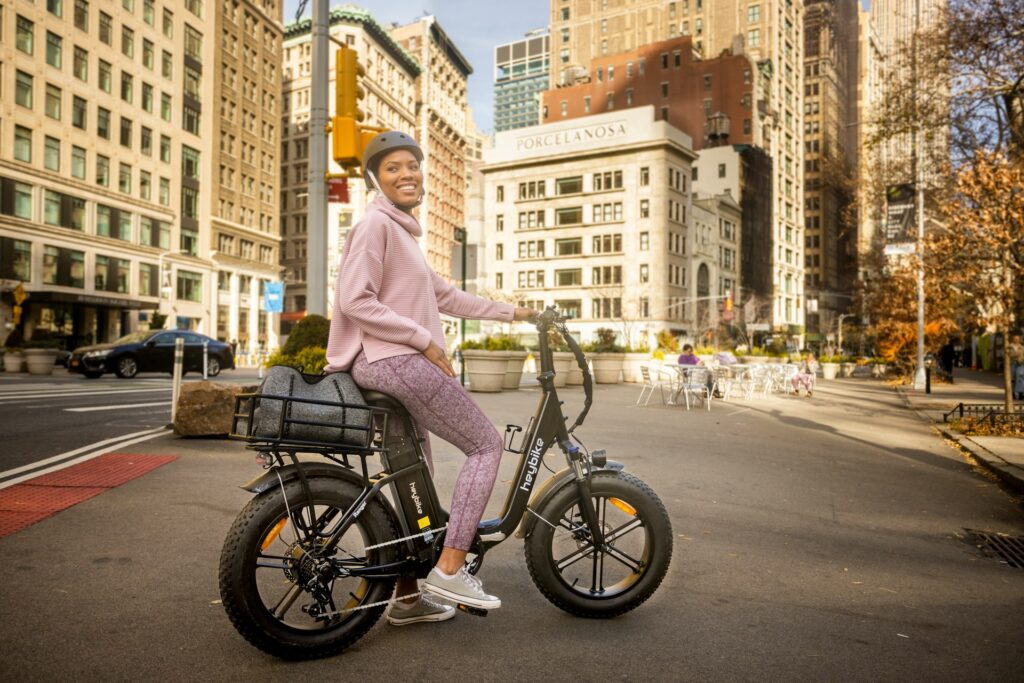
Electric bikes, or e-bikes, are becoming increasingly popular as a convenient and eco-friendly mode of transportation. They offer the perfect blend of traditional cycling and motorized assistance, making them accessible for people of all ages and fitness levels.
However, before you hop on your e-bike and start riding, there are several important things you should know to ensure a safe and enjoyable experience. This article covers the essential aspects you need to consider before hitting the road on your e-bike.
Table of Contents
- 1 Here are some more FAQS about riding an e-bike:
- 1.1 What do I need to know about riding an electric bike?
- 1.2 What to check when buying an ebike?
- 1.3 How to ride an e-bike efficiently?
- 1.4 What are the most important features of ebikes?
- 1.5 How to learn to ride an ebike?
- 1.6 Is riding an ebike hard?
- 1.7 What is the best use of ebike?
- 1.8 How long will my ebike last?
- 1.9 How do I choose my first e-bike?
- 1.10 Do Ebikes help uphill?
- 1.11 How to make your e-bike battery last longer?
- 1.12 How to ride an electric bike uphill?
- 1.13 How to stop on an eBike?
- 1.14 What do I need to know before buying an eBike?
- 1.15 Are e-bikes easy to ride for beginners?
1. Understanding Your E-Bike’s Capabilities
Before you start riding your e-bike, it’s crucial to understand its capabilities and limitations. E-bikes come in various models, each with different features such as motor power, battery life, and maximum speed. Knowing these details can help you make the most of your ride and avoid potential issues.
First, familiarize yourself with the motor power and battery specifications. E-bikes typically have motors ranging from 250 watts to 750 watts. The motor power affects how much assistance you’ll get while pedaling and the bike’s overall performance. A more powerful motor can handle steeper hills and provide a smoother ride, but it will also consume more battery power.
Battery life is another critical factor. Most e-bikes can travel between 20 to 60 miles on a single charge, depending on the battery capacity and riding conditions. It’s essential to know your e-bike’s range to plan your trips and avoid running out of battery mid-ride. Additionally, understand the charging time required for your battery and have a plan for regular charging.
2. Familiarize Yourself with Each E-Bike Class
E-bikes come equipped with motors, allowing them to achieve higher speeds than traditional bicycles. However, the speed and mechanisms of e-bikes can vary, which has led to the establishment of different classifications to ensure safety and regulation compliance. In the United States, there are three ebike classes based on each e-bike’s speed capabilities and how it is powered. Knowing these classifications is crucial for choosing the right e-bike for your needs and understanding the safety regulations associated with each class.
Class 1 e-bikes are pedal-assisted bikes, meaning the motor kicks in only when you pedal. These e-bikes can reach speeds of up to 20 mph, at which point the motor assistance will automatically stop. This class of e-bike is ideal for those who enjoy the traditional feel of cycling but want a bit of extra help, especially on inclines or longer rides.
Class 2 e-bikes have a throttle that provides power without the need to pedal. The motor can propel the bike up to 20 mph purely through the use of the throttle. This type of e-bike is perfect for riders who may have physical limitations or prefer not to pedal continuously. With a separate throttle control, you can ride your e-bike much like a scooter, making it a versatile option for various riding preferences.
Class 3 e-bikes, known for their speed, can reach up to 28 mph but require pedal assistance to activate the motor. These bikes are often referred to as speed pedelecs and are popular among commuters who need to travel longer distances quickly. However, due to their higher speeds, Class 3 e-bikes are subject to more stringent regulations and may not be allowed on all bike paths and trails.
3. Safety Gear and Precautions
Riding an e-bike can be a thrilling experience, but safety should always be a priority. Ensuring you have the right safety gear and taking necessary precautions can prevent accidents and injuries. The most critical piece of safety equipment is a helmet. Always wear a certified helmet that fits properly to protect your head in case of a fall or collision.
In addition to a helmet, consider wearing other protective gear such as gloves, knee and elbow pads, and reflective clothing. These items provide extra protection and increase your visibility to other road users, especially when riding at night or in low-light conditions.
Before you start riding, inspect your e-bike to ensure it’s in good working condition. Check the brakes, tires, and lights regularly. Make sure the battery is securely mounted and fully charged. Familiarize yourself with the controls and practice using them in a safe, open area before heading out on busy roads.
4. Planning Your Route
Planning your route before riding your e-bike can make your journey more enjoyable. E-bikes are versatile and can handle various terrains, but it’s essential to choose a route that matches your skill level and the capabilities of your bike. Consider factors such as distance, elevation, and road conditions when planning your trip.
If you’re new to e-biking, start with shorter, easier routes to build your confidence and get a feel for how your e-bike handles different surfaces. Gradually increase the distance and difficulty as you become more comfortable. Use online maps and apps to find bike-friendly routes and trails in your area.
Take note of charging stations along your route, especially if you’re planning a longer ride. Some public places, such as parks and bike shops, offer charging facilities for e-bikes. Knowing where these are located can give you peace of mind and prevent range anxiety.
5. Understanding Local Laws and Regulations
Before riding your e-bike, it’s crucial to familiarize yourself with local laws and regulations governing e-bike use. These laws vary by state and city, and understanding them helps ensure that you ride legally and safely. Some areas have specific rules regarding where you can ride e-bikes, speed limits, and age restrictions.
For example, some cities may prohibit e-bikes on certain trails or sidewalks, while others may have designated e-bike lanes. Speed limits for e-bikes can also differ depending on the location and class of the e-bike. Knowing and adhering to these rules helps you avoid fines and ensures a positive riding experience.
Moreover, consider any requirements for insurance, registration, or licensing. While many states do not require e-bike riders to have insurance or a license, it’s always good to check and make sure. Some states might require specific equipment, such as lights and reflectors, for e-bikes ridden at night.
E-biking opens up a world of possibilities for convenient and eco-friendly travel. By understanding the capabilities of your e-bike, familiarizing yourself with the different e-bike classes, equipping yourself with the right safety gear, planning your routes carefully, and adhering to local laws, you can ensure a safe and enjoyable experience.
Embracing these aspects not only enhances your ride but also fosters a sense of confidence and responsibility on the road. As you embark on your e-biking adventures, these considerations will help you make the most of your journey while ensuring you remain safe and compliant with regulations.
Here are some more FAQS about riding an e-bike:
What do I need to know about riding an electric bike?
Riding an electric bike combines pedaling with electric power to make cycling easier and more efficient. It’s important to understand how to control the motor and battery to get the most out of your ride.
What to check when buying an ebike?
When buying an e-bike, check the battery life, motor power, weight, frame quality, and the type of brakes. Ensure it suits your riding needs and terrain.
How to ride an e-bike efficiently?
To ride an e-bike efficiently, use pedal assist wisely, maintain a steady speed, and shift gears appropriately. Avoid sudden accelerations and use the motor assistance only when needed.
What are the most important features of ebikes?
The most important features of e-bikes include battery capacity, motor power, frame durability, braking system, and overall weight. Consider additional features like suspension and built-in lights based on your needs.
How to learn to ride an ebike?
Start by getting comfortable with the controls, practicing in a safe, open area. Gradually increase the use of pedal assist and motor power as you gain confidence.
Is riding an ebike hard?
Riding an e-bike is generally easier than a traditional bike due to the motor assistance. Beginners might take a bit of time to get used to the extra weight and controls.
What is the best use of ebike?
E-bikes are best used for commuting, leisure rides, hill climbing, and longer distances where motor assistance can reduce fatigue and make the ride more enjoyable.
How long will my ebike last?
The lifespan of an e-bike depends on the quality of its components and how well it is maintained. Typically, an e-bike can last between 3 to 5 years with proper care.
How do I choose my first e-bike?
Choose your first e-bike based on your riding style, terrain, and needs. Consider factors like battery life, motor power, frame type, and additional features such as suspension and cargo capacity.
Do Ebikes help uphill?
Yes, e-bikes provide significant assistance when riding uphill, making it much easier to climb without exerting as much physical effort.
How to make your e-bike battery last longer?
To make your e-bike battery last longer, avoid full discharges, charge it regularly, store it in a cool, dry place, and avoid exposing it to extreme temperatures.
How to ride an electric bike uphill?
To ride an electric bike uphill, use a lower gear and increase the pedal assist level. Maintain a steady pace and avoid sudden changes in speed.
How to stop on an eBike?
To stop on an e-bike, gradually reduce the motor assistance, apply the brakes evenly, and shift to a lower gear if necessary for a smooth stop.
What do I need to know before buying an eBike?
Before buying an e-bike, know your riding needs, understand the different types of e-bikes, check the battery and motor specifications, and consider the warranty and after-sales support.
Are e-bikes easy to ride for beginners?
Yes, e-bikes are generally easy to ride for beginners due to the added assistance from the motor, which makes pedaling less strenuous and more enjoyable.
